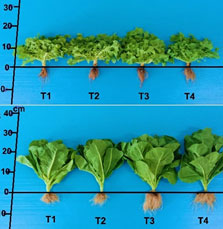Growth of Lettuce Stimulated by Indole-3-Acetic Acid (IAA) from Cyanobacteria Isolated from Paddy Field Soil
Keywords:
cyanobacteria, indole-3-acetic acid, lettuceAbstract
Cyanobacteria possess high capability on producing indole-3-acetic acid (IAA), can be serve as a biostimulant for promoting plant growth. The objective of this research was to isolate and identify cyanobacteria that are effective in producing IAA, as well as to investigate the impact of cyanobacteria on the growth of lettuce. The experiment was started from 1) The isolation of cyanobacteria from 5 paddy fields located in Nakhon Pathom, Kanchanaburi, and Suphanburi Province using a blue-green algae nitrogen-free medium (BGA). 2) Morphological study and identification of cyanobacteria was conducted through molecular biological methods utilizing the 16S rRNA gene and the phylogenic tree. 3) The efficiency on IAA production of cyanobacteria was assessed in BGA medium with and without tryptophan for 7, 14, 21, and 28 days. 4) The efficiency of cyanobacteria on growth promoting of lettuce was evaluated in greenhouse. The most effective IAA producer was selected for pot experiment. The experiment was completely randomize design (CRD) consisted of 4 treatments with 5 replicates each: T1 control with no fertilizer, T2 100% chemical fertilizer, T3 50% chemical fertilizer and cyanobacteria, and T4 only cyanobacteria. The results revealed that a total of 10 cyanobacteria isolates produced IAA in the range of 0.57 to 1.55 mg/ml. The Nostoc sp. (TL02) exhibited the highest IAA production of 1.55 mg/ml at 21 days in BGA with tryptophan. In the greenhouse experiment, using a 50% chemical fertilizer and cyanobacteria (TL02), there were no significant differences in plant height, fresh weight, and dry weight among the 3 lettuce varieties. However, the root length of the Green Cos variety showed a statistically significant difference at 11.00 cm. The highest dry weights for green oak, Green Cos, and Butterhead roots were 3.44 g, 10.64 g, and 3.84 g, respectively. This indicated that Nostoc sp. effectively enhanced the growth of lettuce roots, likely through IAA production. It can be used as a biofertilizer together with chemical fertilizers.
References
กองวิจัยพัฒนาปัจจัยการผลิตทางการเกษตร กรมวิชาการเกษตร. 2564. การใช้ปุ๋ยตามค่าวิเคราะห์ดินในการผลิตพืชผักที่ปลูกเพื่อรับประทานต้นและใบ. (ระบบออนไลน์). แหล่งข้อมูล: www.doa.go.th/ac/phetchaburi/wp-content/uploads/2023/02 (15 เมษายน 2566).
วิภา จึงจตุพรชัย. 2561. ไซยาโนแบคทีเรียและจุลสาหร่าย:พันธุศาสตร์ระดับโมเลกุลและเทคโนโลยีชีวภาพ. อมรินทร์
พริ้นติ้งแอนด์พับลิชชิ่ง จำกัด (มหาชน), กรุงเทพมหานคร. 160 หน้า.
ศรัญญา บัวกระสินธุ์, นวลกมล อำนวยสิน, สุธีรา ลิมปิพิชัย และสุเปญญา จิตตพันธ์. 2559. การชักนำการเจริญเติบโตของกรีนโอ๊ค (Lactuca sativa var. crispa L.) ด้วยไซยาโนแบคทีเรียที่สามารถตรึงไนโตรเจนได้โดยใช้คลื่นความถี่สูง. วารสารวิจัยและพัฒนา มจธ. 39(2):171-182.
อริสรา ผาสุข. 2562. การเจริญเติบโต การสะสมและการลดปริมาณไนเตรทในผักสลัดที่ปลูกด้วยระบบไฮโดรโปนิกส์แบบDRFT. วิทยานิพนธ์วิทยาศาสตรมหาบัณฑิต. มหาวิทยาลัยมหาสารคาม, มหาสารคาม. 107 หน้า.
อานนท์ ทัศนานนท์ชัย. 2558. การใช้ประโยชน์ไซยาโนแบคทีเรียบางชนิดที่สร้างเฮทเทอโรซีสต์เพื่อเป็นแหล่งไนโตรเจนสำหรับปลูกข้าวพันธุ์ กข 31. วิทยานิพนธ์วิทยาศาสตรมหาบัณฑิต. มหาวิทยาลัยเกษตรศาสตร์, นครปฐม. 85 หน้า.
Angulo, J., M.M. Martínez-Salgado, R. Ortega-Blu and P. Fincheira. 2020. Combined effects of chemical fertilization and microbial inoculant on nutrient use efficiency and soil quality indicators. Scientia Agropecuaria 11(3):375-380.
Chandra, R. and V. Kumar. 2017. Phytoremediation: A Green sustainable technology for industrial waste management. pp 1-42. In: R. Chandra, N.K. Dubey and V. Kumar (Eds.). Phytoremediation of Environmental Pollutants. CRC Press, Boca Raton.
Datta, C. and P.S. Basu. 2000. Indole acetic acid production by a Rhizobium species from root nodules of a leguminous shrub, Cajanus cajan. Microbiological Research 155(2):123-127.
Ehmann, A. 1977. The Van Urk-Salkowski reagent—a sensitive and specific chromogenic reagent for silica gel thin-layer chromatographic detection and identification of indole derivatives. Journal of Chromatography A 132:267-276.
Hussain, A., S.T. Shah, H. Rahman, M. Irshad and A. Iqbal. 2015. Effect of IAA on in vitro growth and colonization on of Nostoc in plant roots. Frontiers in Plant Science 6(46):1-9.
Kim, M.J., Y. Moon, D.A. Kopsell and S. Park. 2016. Nutritional value of Crisphead ‘Iceberg’ and Romaine lettuces (Lactuca sativa L.). Journal of Agricultural Science 8(11):1. doi:10.5539/jas.v8n11p1.
Knema team. 2021. The production of lettuce and chicory in Thailand. (Online). Available Source:https://knoema.com/data/thailand+agriculture-indicators-production+lettuce-and-chicory (November 9, 2023)
Macherey-Nagel GmbH & Co. KG. 2010. Genomic DNA from tissue user manual. User manual. (Online): Available Source:https://www.mediray.co.nz/media/16169/om_machereynagel_dna_mn740952_
genomicdnatissue_r11.pdf (Apil 2, 2023).
Mohsen, A.A.M., A.S.A. Salama and F.M.A. El-Saadony. 2016. The effect of foliar spray with cyanobacterial extracts on growth, yield and quality of lettuce plants (Lactuca sativa L.). Middle East Journal of Agriculture Research 5(1):90-96.
Randa, M., Z. Ahlam, A.M. Mehesen, E.H. Ashour and A.H. Afify. 2021. Characterization of soil indigenous cyanobacterial strains and bioactivity assessment. Journal of Agricultural Chemistry and Biotechnology 12 (11):195-199.
R Core Team. 2018. R: A language and environment for statistical computing. R Foundation for Statistical Computing, Vienna. (Online): Available Source:https://www.R-project.org (October 2, 2023).
Sergeeva, E., A. Liaimer and B. Bergman. 2002. Evidence for production of the phytohormone indole-3-acetic acid by cyanobacteria. Planta 215: 229-238
Song, X., J. Zhang, C. Peng and D. Li. 2021. Replacing nitrogen fertilizer with nitrogen-fixing cyanobacteria reduced nitrogen leaching in red soil paddy fields. Agriculture, Ecosystems and Environment 312: 107320. doi:10.1016/j.agee.2021.107320.
Stanier, R.Y. and G. Cohen-Bazire. 1977. Phototrophic prokaryotes: The Cyanobacteria. Annual Reviews in Microbiology 31:225-274.
Tamura, K., G. Stecher, D. Peterson, A. Filipski and S. Kumar. 2013. MEGA6: Molecular evolutionary genetics analysis version 6.0. Molecular Biology and Evolution 30(12:) 2725-2729.
Wang, B., J. Chu, T. Yu and J. Li. 2015. Tryptophan-independent auxin biosynthesis contributes to early embryogenesis in Arabidopsis. Biological Sciences 112 (15):4821-4826.






